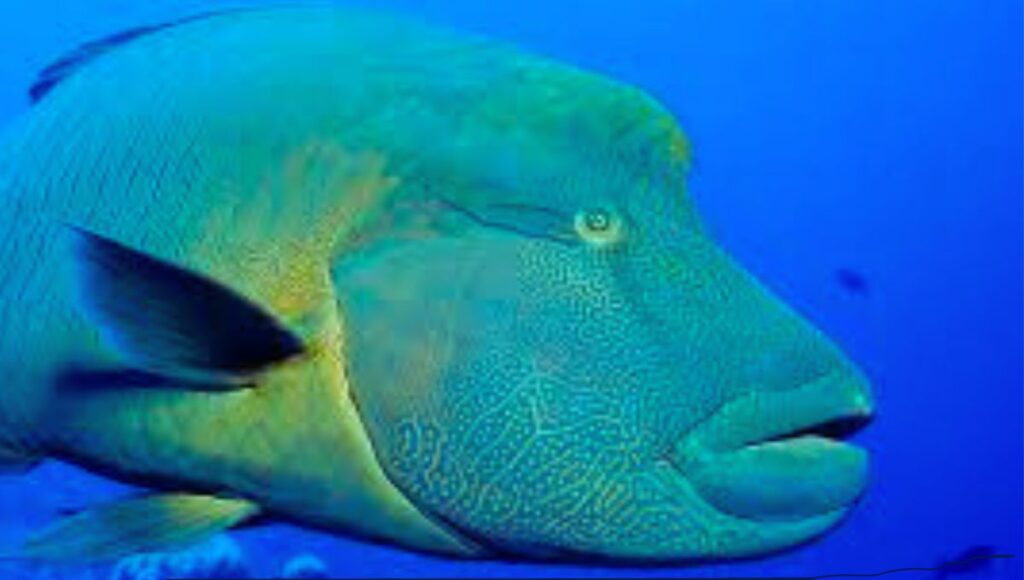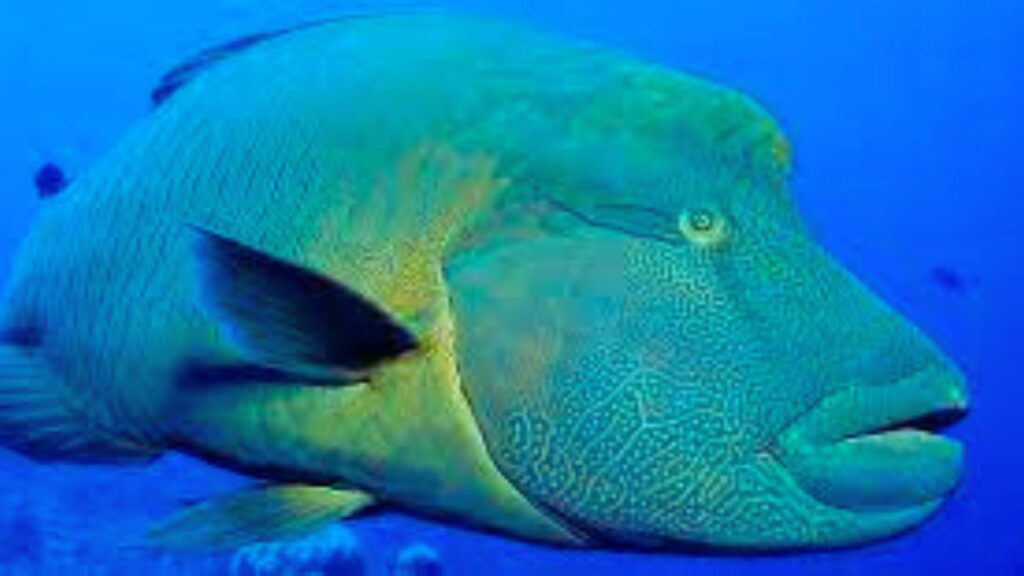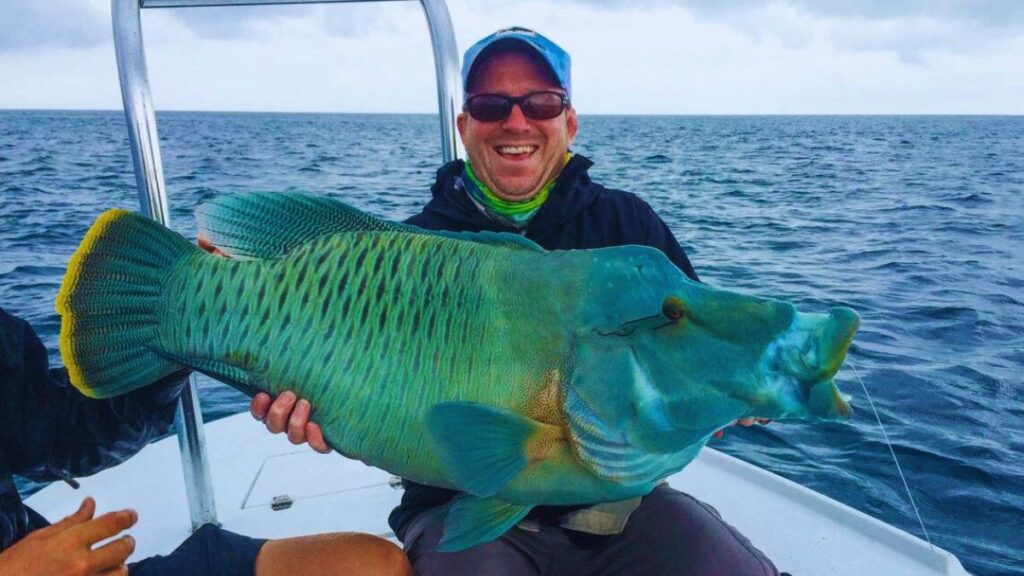Humphead wrasse, also known as Napoleon wrasse or Napoleon fish, is endemic to the coral reefs in the Indo-Pacific region. In this article, we will delve into the world of Humphead wrasse and find out some lesser-known facts about the creature.

Table of Contents
Humphead Wrasse- In a Glimpse:
| Common Name: | Humphead Wrasse |
| Scientific Name: | Cheilinus undulatus |
| Other Names: | Māori wrasse, Napoleon wrasse, Napoleon fish |
| Sexual Dimorphism? | Yes, males are larger |
| Adult Length: | 1-2 meters |
| Adult Weight: | 100-180 kgs |
| Adult Colour: | Light blue-green, dark green or purple-blue |
| Juvenile Colour: | white |
| Lifespan: | 30 years |
| Distribution: | Indo-Pacific Ocean |
| Habitats: | Shallow coral reefs and lagoons |
| Diets: | Invertebrates and fishes |
| Distinct Features: | protogynous hermaphrodites or they can change sex. |
| Sexual Maturity: | 5-7 years |
| Predators: | Large sharks |
| IUCN Status: | Endangered |
| CITES: | Appendix II |
Fascinating Facts About Napoleon Wrasse:
Scientific Classification:
| Domain: | Eukaryota |
| Kingdom: | Animalia |
| Phylum: | Chordata |
| Class: | Actinopterygii |
| Order: | Labriformes |
| Family: | Labridae |
| Genus: | Cheilinus |
| Species: | Cheilinus undulatus |
Physical Appearance:
It is the largest member of Labridae family. Sexual dimorphism is present in Humphead wrasse. The males are larger than females and can be as long as 2 meters and weigh around 180 kg, whereas the females can rarely reach 1 meter in length.

The wrasse can be easily identified by its large size, thick lips, two black lines behind its eyes, and the hump on the foreheads of larger adults. The colour of adults varies from light blue-green to dark green or purple-blue. Adults are generally solitary by nature but sometimes they are seen in pairs. The juveniles are white with dark scale bars but with maturity change their colour.
Similar to other members of the wrasse family, Humphead wrasse can change sex. Some individual that born female, ends up being male and vice versa. Studies are still going on how the species change their sex.
Lifespan:
The male Napoleon wrasse can live up to 30 years whereas females can live up to 50 years.
Distribution and Habitat:
The wrasse species are found around the Red Sea on the east coast of Africa and in some parts of the Indo-Pacific Ocean. The species ranges between the Ryukyu Islands and New Caledonia in the Pacific.
The juveniles are found in shallow, sandy ranges bordering coral reef waters while the adults prefer to live in the offshore and deeper areas of coral reefs and also in lagoons.
Feeding Behaviour:

Humphead wrasses are very opportunistic predators. The species primarily prey on invertebrates like molluscs, gastropods, as well as pelecypods, echinoids, crustaceans, and annelids and fish. As most of the echinoids and pelecypods hide under sand, the wrasse needs to rely on fishes like stingrays. They unveil the hidden echinoids and pelecypods by ejecting water to displace sand and nosing around for prey.
Like other wrasses, they love to crack sea urchins by carrying them in their mouths and slamming them against the rock. The Napoleon wrasses sometimes also engage in cooperative hunting with roving or spotted coral grouper.
Diets:
Invertebrates, Mollusca, reef fish, stingrays, sea urchins, and crustaceans are their primary diets. The Humphead wrasses are one of the few species which can consume toxic species like sea hares, boxfish and sea stars.
Reproduction:

The Humphead wrasses are usually long-lived but have a slow-breeding rate. The wrasses become sexually mature at the age of five to seven years. The species are protogynous hermaphrodites, or they can change sex at a point in their life. When why and how the species change their sex is still understudied. It is observed that some females change their sex and become male at the age of 9-10 years.
At a certain time of the year, adults move to the down-current end of the reef and form local spawning groups or aggregations. The species don’t like to travel far due to their spawning aggregation. The pelagic eggs, which are 0.65 mm in diameter and spherical shaped with no pigments and larvae ultimately settle on or near coral reef habitats.
Threats:
The Napoleon wrasses face many anthropogenic threats and that causes a decline in their population. Some of the threats include:

- Habitat loss and degradation,
- Destructive fishing techniques, including bombs and cyanide practised in Indonesia,
- Local consumption and delicacy for tourists,
- Increasing export of juveniles for aquariums around the world,
- Illegal and unregulated fishing in the areas and no strong laws in countries like Indonesia, Papua New Guinea etc to curb it.
- Destruction of coral reefs also poses a major challenge that affects the Humphead wrasses.
Predators:
Napoleon wrasses have only a few natural predators. The potential predators of the wrasses include larger reef fishes and sharks.
Conservation Status:
Humphead wrasses are listed as “Endangered” in the IUCN Red List of Threatened Species and also listed in Appendix II of CITES. It is very alarming that the populations of the species are decreasing rapidly.
Best Destination to find Humphead Wrasse:
You can visit the places or countries given below to find the wrasses:
- New Caledonia
- Australia
- Maldives
- Andaman & Nicobar Island
- Seychelles
- Madagascar.
Also Read: Swift Fox: Everything About The Icon of Prairies
Also Read: Smooth Snake: United Kingdom’s Rarest Native Reptile
Also Read: When Animal Defies Nature: The Only Male To Get Pregnant